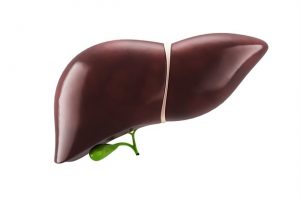Adverse muscle composition can predict mortality risk in people with fatty liver disease

Obesity and a sedentary lifestyle contribute to an increasing number of people developing fatty liver disease. There is a need for early detection of individuals at risk of developing sequelae. According to a new study, poor muscle health may be a marker of risk for this. The study, published in JHEP Reports, shows that low muscle volume in combination with high muscle fat infiltration is associated with an increased mortality risk in people with fatty liver disease.
The liver is a storage site for energy, in the form of sugar and fat, but also for other important nutrients such as vitamins and iron. A healthy liver contains only a small amount of fat. But sometimes there is too much, and the amount of fat amassed is so large that it is called fatty liver disease. This disease can be caused by heavy alcohol consumption. However, most people with fatty liver disease are not excessive drinkers. In recent years, research has shown that obesity and type 2 diabetes are at least equally important contributors.
Globally, about one in four adults are estimated to have non-alcoholic fatty liver disease (NAFLD). Its prevalence in Sweden is probably somewhat lower, but NAFLD is already a common problem that is expected to increase as obesity becomes more prevalent. Most people are unaware that they have a fatty liver. The challenge lies in finding the relatively few individuals with fatty liver disease that develop permanent liver damage, which could be life-threatening. Researchers are therefore trying to find methods for early identification of individuals running the highest risk of impaired liver function.
In the study, the researchers focused on participants’ muscle status, as poor muscle health and function is common in lifestyle-related diseases such as obesity, type 2 diabetes and NAFLD. Poor muscle health is also associated with worse prognosis in late stages of liver disease. It is however still unclear which is the chicken, and which is the egg, i.e. whether muscle health has deteriorated due to the disease, or whether poor muscle health may precipitate the disease.
The study is based on the UK Biobank, where volunteers are scanned using magnetic resonance imaging (MRI). From the images of about 40,000 individuals, the scientists measured the amount of fat in the liver as well as muscle composition. About 5,000 participants turned out to have NAFLD, and a low thigh muscle volume combined with high muscle fat infiltration was identified as an adverse muscle composition. In addition, the study also assessed the participants’ functional performance, including hand grip strength, walking pace and ability to climb stairs.
We found that just by looking at muscle composition we can predict which individuals with fatty liver disease are most likely to die.”
Jennifer Linge, PhD student at the Department of Health, Medicine and Caring Sciences (HMV) at Linköping University and researcher at Amra Medical AB
The association between muscle composition and mortality was not affected by whether functional performance was good or bad.
It also turned out, somewhat surprisingly, that having fatty liver disease was not associated with a worsened prognosis in the study. Although this is in line with several previous studies, the result contradicts the prevailing view that fatty liver disease is strongly associated with development of cardiovascular disease, and death. One explanation for why studies reach different conclusions could be that many studies are based on hospital patient groups, and not the population in general, as in this case, which gives a different picture. According to the researchers, the findings of the study highlight the need for better diagnostics to identify individuals with a worse prognosis.
“We find muscle composition a very exciting component in understanding which individuals are at risk of developing serious illness, or dying. In ongoing research, we are learning more about how factors such as diet, exercise and various medicines affect muscle composition. But it is also important to understand whether improved muscle composition affects prognosis,” says Mattias Ekstedt, senior associate professor at the Department of Health, Medicine and Caring Sciences at LiU and consultant in gastroenterology and hepatology at the University Hospital in Linköping.
The study was carried out as a collaboration between researchers at Linköping University and the company Amra Medical AB, which is a spin-off from the Center for Medical Image Science and Visualization (CMIV) at Linköping University. Some of the co-authors of the study are part owners or employees of Amra Medical AB. The study has received financing from Pfizer Inc. and Region östergötland.
Linköping University
Linge, J., et al. (2022) Adverse muscle composition is a significant risk factor for all-cause mortality in NAFLD. JHEP Reports. doi.org/10.1016/j.jhepr.2022.100663.
Posted in: Medical Science News | Medical Research News | Medical Condition News
Tags: Alcohol, Cardiovascular Disease, Diabetes, Diagnostics, Diet, Exercise, Fatty Liver, Gastroenterology, Hepatology, Hospital, Imaging, Liver, Liver Disease, Magnetic Resonance Imaging, Medicine, Mortality, Muscle, Nutrients, Obesity, Research, Running, Type 2 Diabetes, UK Biobank, Vitamins, Walking
Source: Read Full Article